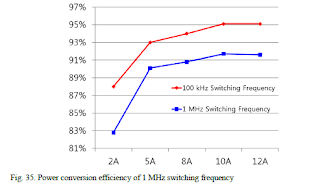domingo, 16 de agosto de 2020
Updating and Customizing an industrial UPS HMI-A Master's Thesis Submitted to the Faculty of the Escola Tècnica d'Enginyeria de Telecomunicació de Barcelona Universitat Politècnica de Catalunya by Ali Ahmadi
quinta-feira, 13 de agosto de 2020
Optimal Design Method of the LLC resonant converter using the hybrid current balancing circuit for LED lighting -Author Jin-Gu Kim Department of Electrical & Medical Convergent Engineering Graduate School, Kangwon National University South Korea.
Optimal Design Method of the LLC resonant converter using the hybrid current balancing circuit for LED lighting Author Jin-Gu Kim
Department of Electrical & Medical Convergent Engineering Graduate School, Kangwon National University South Korea.
Abstract
In this thesis, a novel hybrid current balancing circuit and an optimum design of LLC resonant converter for driving a current balancing circuit are proposed.
First of all, the hybrid current balancing circuit was proposed for compensating current deviation among LED strings. LEDs have been widely used in lighting, automobiles, and airplanes owing to their excellent light output characteristics and long lifespan. Though LEDs are manufactured under the same process, variations in impurity concentrations cause electrical deviation among LEDs. This electrical deviation results in current unbalance of LED strings. The resulting current unbalance does not only reduce the life time of the LED but also cause non-uniform luminance of LEDs connected in parallel. The LED driving circuit is researched to solve the above problems. In this thesis, a novel hybrid current balancing circuit with a Y-type current balancing transformer and a voltage doubler rectifier circuit was proposed for the compensation of 6 LED strings with a simple structure.
Secondly, the Optimal design method of LLC resonant converter for driving hybrid current balancing circuit was proposed. The difference between the proposed optimal design method of LLC resonant converter and conventional design method can be divided into three categories.
First of all, when designing transformer with leakage inductance(Lr ) and magnetizing inductance(Lm), unwanted leakage inductance of secondary side (Lr2) which cause error in the process of measuring the leakage inductance (Lr ) with instrument occurs. This design error could be reduced by taking into account the leakage inductance of secondary side(Lr2).
Secondly, in general, the voltage gain characteristic curve is applied to design LLC resonant converter. in this thesis, the current gain characteristic curve was applied to the design process which is suitable for LED that is non-linear load and necessary to be controlled to a constant current.
Lastly, the equivalent circuit of LED was applied to the design process. Normally, a resistive load which has linear load characteristic is used for designing the LLC resonant converter. However, in this thesis, the equivalent circuit of LED which includes a voltage source, a resistor and a diode could be obtained by using the linear approximation method. This circuit was then applied to the design process for reducing design error.
Experimental results are presented to verify the performance of the proposed hybrid current balancing circuit and the optimal design method of the LLC resonant converter. The LED maximum current error rate which was 19.57% was reduced to 4.5% by Y-type current balancing transformer. Also, the validity of the proposed optimal design method of the LLC resonant converter was verified by comparing it with the conventional design method. An 150W prototype was implemented and used for the performance verification of the hybrid current balancing circuit and the LLC resonant converter.
terça-feira, 11 de agosto de 2020
Master's Thesis Design, Control, and Implementation of High Frequency LLC Resonant Converter-Author- Hwa-Pyeong Park Department of Electrical and Computer Engineering -ULSANG NATIONAL INSTITUTE OF SCIENCE AND TECHNOLOGY
Master's Thesis
















































 JOSIL ARTISTA PLASTICO FORTALEZA CEARA BRASIL AV.HERACLITO GRAÇA 41 TEL(85)32542378
JOSIL ARTISTA PLASTICO FORTALEZA CEARA BRASIL AV.HERACLITO GRAÇA 41 TEL(85)32542378
















